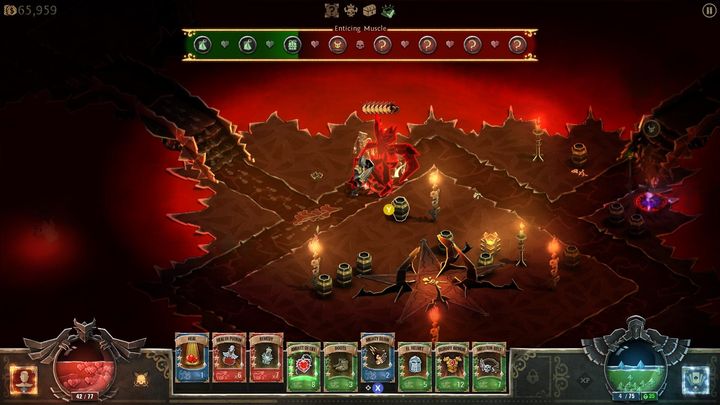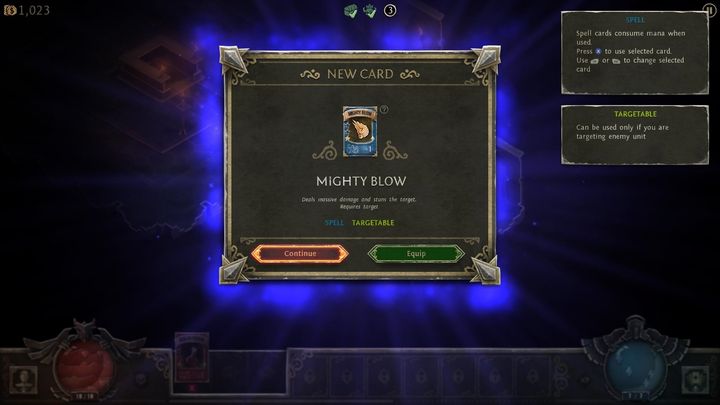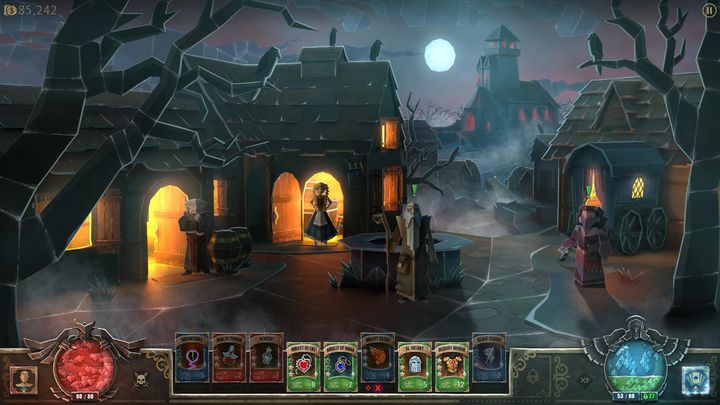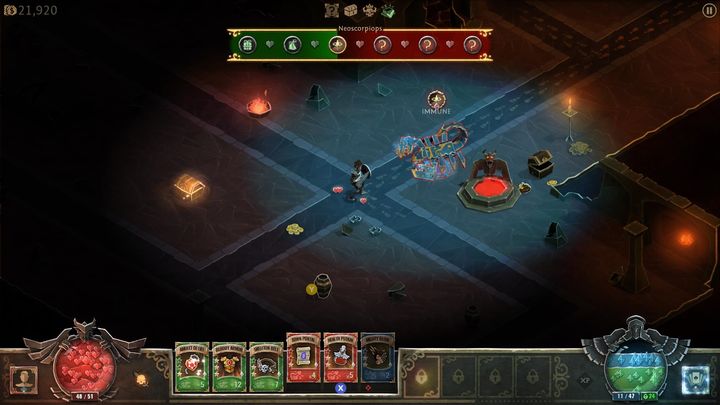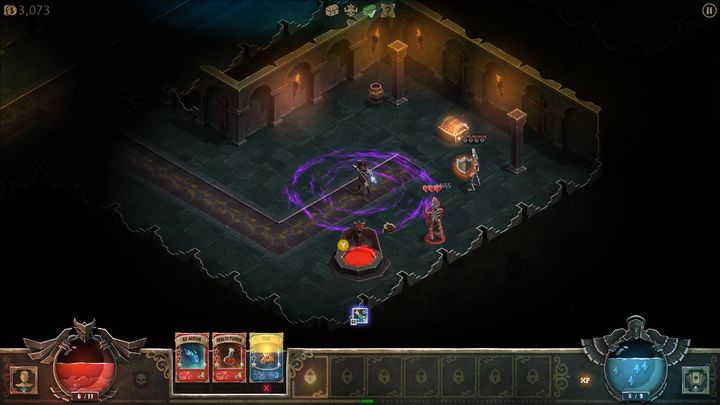Hack and slash, dungeon crawling games have been in vogue since Blizzard’s Diablo entered the scene back in 1996. And Book of Demons by developer Thing Trunk is the latest example of the genre, a fun Diablo clone which brings a few ideas of its own to the table, but one which isn’t without its share of quirks as we’ll see later in this review.
Book of Demons story will be familiar to anyone who has played the Diablo games: evil has set up shop beneath the town’s cathedral, and its up to an intrepid hero to reach the bottom level and deal with the nefarious Archdemon which is corrupting the land. In between, you’ll have to clear dungeons of enemies and pick up loot, levelling up and gaining new abilities as your go along.
One difference between Book of Demons and games like Diablo is that special abilities and attacks are gained by equipping cards. You will come across these cards as you explore the dungeons, and initially you can have up to three of these equipped at once.
You are able to unlock a further seven slots (up to a total of ten) throughout the game. And give that you can swap cards at any time there are many gameplay possibilities here, letting you fine tune your playstyle throughout the game.
Aside from card-based abilities, Book of Demon’s also features the “Flexiscope”. This is a feature of the game which lets you set the size of the next section of the game (from small to large). This is an innovative feature, and comes in handy if you want to make your game shorter or longer. You’ll have to fight your way through more and bigger dungeons in the latter case, but doesn’t make as much difference as you might expect to the overall experience.
Also, and like in the Diablo games, dungeons are randomly generated here – definitely a plus if you want to play through the game more than once, something you might be inclined to do in order to try the other two characters classes aside from the warrior featured in the game.
You might not like the fact, though, that the other two classes (rogue and mage) have to be unlocked first. And although this doesn’t take too long (about 20 minutes) you might find the unavailability of the other two classes at the start an unnecessary hindrance.
After choosing a class and naming my character, I was in the dungeons proper, and truth be told I was disappointed at first. Unlike other dungeon crawlers, this game features “on-rails” movement. That is, your character’s movement in the dungeon is restricted to a track, and you use the gamepad’s left stick to move through it.
This does feel slightly restrictive in this day and age truth be told. Heck, even games like 1985’s classic Gauntlet offered more freedom of movement than Book of Demons does. To compensate for the “on-rails” movement, moving the gamepad’s right stick brings up a cursor that lets you grab gold, items and point at monsters to attack which may be sitting on a spot in the current room you might not be able to physically walk to.
This feels slightly awkward at first, but once I got used to Book of Demon’s movement limitations it did not bug me so much during my playthrough. Plus, the way characters move in the game makes sense taking into account that Book of Demons is set in a “paper world” and that these are meant to be “paper dungeons”, justifying the two-dimensional movement somewhat.
A consequence of the 2D quality of the graphics is that sometimes it’s hard to distinguish different enemy types – they all looked like some variant of skeleton or zombie to me at first. Ultimately though, I was able to appreciate the variety of enemies available for slaying here – gargoyles, skeletons, zombies, ghosts (which make slightly funny noises when attacking), scorpions and the Archdemon, the game’s final boss, are ready to be cut down by your sword, bow and arrow or magic missiles.
Of course, you can also die at the hands of any of these creatures, thereby you’ll resurrect in town. Here, you can talk to the healer in order to refill your health and mana bars (these are orb-shaped like in the Diablo games).
Aside from the healer, three other characters can deliver aid as well as gossip in town. For starters, there’s the barmaid, from whom you can purchase the contents of a magical cauldron which gets filled as you play the game, granting extra mana points amongst other things. Like in Diablo and its ilk, mana is used to power the special abilities granted by some cards.
The Sage is someone you’ll want to visit in order to unlock other card slots, and also someone who can identify cards for you. You see, some cards you pick up in the dungeon provide unknown perks, and need to be identified first. Aside from this, listening to the Sage’s gossip will let you know more about some of the creatures you’ve encountered in the dungeons so far and other things, some of which are quite funny (the man’s not on good terms with the fortune teller who’s set up shop recently it seems).
This talk is fun to listen to (and very Diablo-ish too), although some of these monologues such as the Healer’s can be slightly dull. Overall, though, I enjoyed the stories Book of Demon’s characters had to tell back in town, and wish there was more of this gossip to listen to throughout the game.
Back in town, you can also deal with the fortune teller, a woman who can recharge your cards and also lets you upgrade your deck of cards. You see, some cards like the health potion card can be recharged by paying gold, as these only allow a certain number of uses before recharging. This card can also be upgraded by paying a certain amount of gold to allow more uses during combat, letting you completely recover your health when on the brink of death (or at any other time). Other cards such as the “Mighty Blow” card, which lets you hit a single enemy very hard, with the possibility of stunning said enemy, can also be upgraded to increase their power.
Upgrading your cards makes you more of a force to reckon with in battle, of course, but it’s not that Book of Demons is particularly hard to begin with. You will breeze through the early levels, and it’s only in the later sections of the game (which as you might imagine are set in hell, something to be expected from a Diablo-inspired game) the difficulty ramps up.
Actually, I encountered a difficulty spike right before the final battle with the Archdemon. In order to open a magically sealed gate, I had to dispatch two boss enemies, the first of these wasn’t so hard but the second was something of a tough cookie and took me a while to defeat, as he was able to summon a seemingly endless number of enemies.
This fight was made more complicated by the fact that some enemies can stun your character: to recover, you play a mini-game which involves catching moving stars with an onscreen cursor. This is a fun, short break from combat, except when it happens a bit too many times in a row, as in the aforementioned fight, something which can get annoying.
And you can be sure there’s plenty of fighting in Book of Demons – boss fights are plentiful too. These enemies are introduced with thundering music, have many hit points, and can span other enemies too. Sometimes these are “linked” to the boss – this is shown by dotted lines onscreen – meaning the linked enemies have to be taken out first before the boss can be further harmed. This also made me think a little, as I had to prioritize targets instead of attacking random enemies mindlessly. Also, you might want to take down summoning enemies before anyone else here.
Equipping certain cards can make boss fights and other battles easier though, and truth be told some cards made my character feel overpowered, such as one which spans “hearts” next to my character when hit by monsters – picking these up refilled my health orb letting me last longer in combat.
A nice touch is that the game didn’t let me get comfy after I had found my ideal card configuration. At that point I was on cruise control and thought I would beat the game easily. But then I had to face the “Antipope”, the corrupt bishop of the town who had disappeared in the dungeons below the cathedral, and one of the game’s major bosses.
Upon starting this boss fight, all my equipped cards were taken away from me – forcing me to rely on other cards in my deck during parts of this encounter. In the end, I was able to get back my favourite cards and defeat the boss, but I was pleasantly surprised that the game had managed to keep me on my toes for a while here.
Another interesting gameplay idea related to cards is that certain enemies can “dislodge” your equipped cards with their attacks, nullifying their effects – you’ve got to access the card menu in order to place them in position again. Thankfully, time slows down when accessing the card menu during combat, letting you replace them without fear of death. This adds an interesting dimension to combat, and highlights how dangerous the game’s “paper creatures” are.
You might also like the fact that this is a very colourful game overall, even if I encountered an issue were the screen would darken unexpectedly during some of the battles inBook of Demons’ hell levels, something I found slightly annoying. Despite this, Book of Demons sure has a vivid colour palette and good lightning effects. The game might be a bit too colourful at times though, so you might want to stay away from this game if flashing colours are not your thing…
This all works beautifully in the game though, and for instance levelling up is accompanied by an explosion of colour and your character jumping and doing a 360 in the air as surrounding enemies are pushed back – it really feels like you’ve gotten more powerful.
The music is pretty great throughout too – adding to the game’s atmosphere, also evoking a sense of mystery and dread in the game’s dungeons. The tunes heard in the game’s hell levels are uncannily similar to music heard in Diablo though. There’s also a performance at the end (which I won’t spoil for you here) which makes playing through the game and reaching the end worthwhile.
There’s also plenty of replayability here – as stated earlier in the review, there are three character classes in Book of Demons. When you’ve completed the game with the warrior (the default) you can play through has a rogue or mage. Each of these classes have specific cards in addition to the ones available to all classes, and feel different enough during gameplay and have their own voiceovers too. Add to this the game’s various difficulty levels and the fact that you can set the length of the game via the Flexiscope and this surely is a game which can keep you busy for a while.
However, aside from the quirks already mentioned in the review, I also encountered performance issues. I experienced slowdowns at certain points when running the game on a machine that far exceeds the game’s minimum specs, which was disappointing.
Also, this game won’t be your cup of tea if you don’t like button mashing, as there’s quite a bit of buttong pressing involved here during the major battles as in the Diablo games of yore.
In the end, though, some might argue the existence of Diablo 3 makes this game redundant, especially taking into account that Blizzard’s hack and slash masterpiece can be had for as little as a tenner these days, and is obviously superior to developer Think Trunk’s effort. However, if you’re tired of Diablo and its ilk and are looking for a similar experience with a few novelties such as card-based abilities and a configurable game size, you can’t go wrong with Book of Demons.
Book of Demons
Score: 77 / 100
Available on: PS4 | Xbox One | PC | Nintendo Switch | Other systems
Reviewed on: PC (System: Intel Core i5-8400, 16 GB of RAM, Nvidia GTX 970, SSD Drive)
Publisher: Thing Trunk
Launch date: December 13, 2018
This game was reviewed using a code provided by the publisher.

